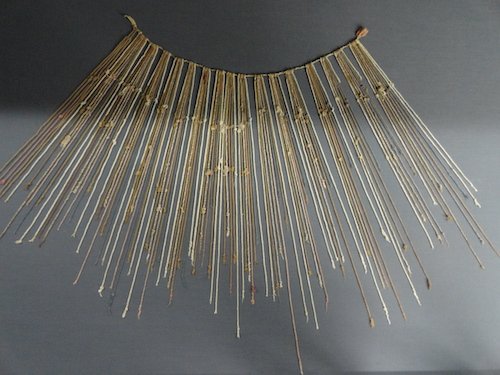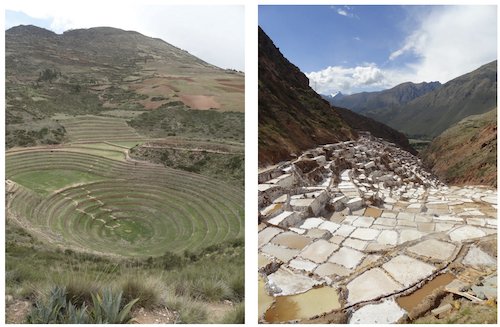Off to Peru, 2010
I don’t remember when I first became fascinated with the notion of visiting Peru, but sometime early in my weaving life I learned about the unparalleled doubleweave pickup textiles that had been woven in pre-Columbian Peru, as well as masterpieces in many other techniques.
Then in the early 1990’s I took a seminar with Ed Franquemont in which he talked about the quipus, the knotted cords that functioned as record keeping devices for the Incan and prior Andean cultures. I was entranced at the thought of cultures that valued textiles more highly than gold, and that used textiles as their means of recording and passing on their culture for future generations.
In July of 2010 I attended Convergence in Albuquerque. I had just spent two years working intensively on writing my book on doubleweave, in addition to my part-time job and a full schedule of teaching workshops around the country. I hadn’t had a break or any breathing room in my life during that time, and I felt that I deserved to treat myself to a special trip somewhere.
It was at Convergence that I learned that Nilda Callañaupa, the founder, director, and driving force behind the Center for Traditional Textiles of Cusco (CTTC), was organizing Tinkuy de Tejedores, a gathering of handweavers, in Urubamba, Peru, for the coming November. Andean Textile Arts, a sponsor of the conference, was also leading a tour to visit some of the weaving communities of CTTC, as well as a number of Incan archeological sites. This seemed like the perfect way for me to celebrate the completion of my book, and I signed up on the spot for both the Tinkuy conference and the tour.
After flying to Lima and spending a short night at the airport hotel, our group met and took a spectacular flight on a small plane over the Andes. We landed in Cusco, a beautiful city that had been the capital of the Incan empire, and then traveled by bus through the Sacred Valley to the outskirts of Urubamba. We stayed in a partially completed hotel and the conference was held in a large thatched roof building on the grounds.
About 300 people attended this conference, mostly from South America, with contingents from Guatemala, Mexico, the U.S. and Canada. We heard talks and panel discussions in English, Spanish and Quechua, with translations in each language. During breaks there were weaving demonstrations on backstrap looms out on the lawn, and in the evenings there was music, dancing, and spinning competitions between Peruvians on drop spindles and Americans on spinning wheels. Altogether, a wonderful cross-cultural exchange.
On the two days following the conference our tour group traveled to Chinchero, Nilda’s home town, and an important weaving center. The first and largest of the ten CTTC weaving centers is in Chichero, and we watched as the members of that community wound warps, wove on backstrap looms, and prepared skeins for dyeing, as well as food for our lunch.
On one of these days we had a choice of workshops to take. I chose to learn how to weave a narrow tubular edging on a small backstrap loom. It looked simple enough, with its basic design and 17 warp ends that were far thicker than the ones used by the Quechua weavers. And yet, as hard as I tried, my design kept going askew and I was continuously corrected by the local weavers who were decades younger than me.
The next day was a full day of natural dyeing led by Nilda. Skeins of pre-washed wool were draped over a fence waiting to be dyed. Nilda showed us the various plant materials, as well as cochineal insects, that would be placed into dye pots that were already boiling over wood fires. We all took turns stirring the dye pots during the morning, and then were called to the center courtyard for an amazing lunch of quinoa soup and a variety of local dishes. After lunch we lifted the skeins out of the dye pots, separated and untangled them, and hung them out to dry on lines. We all got to leave that day with an armful of yarn in an array of gorgeous colors.
Then the tour began! We had a large group - 27 people on a big bus, plus Rene, our fabulous tour guide. This is when I first got to learn about the work of Andean Textile Arts through Betty and Jan, the two representatives on the tour from the nonprofit organization.
We visited a number of incredible Incan archeological sites -
The experimental agricultural site at Moray
and the natural salt beds at Salineras
The ruins at Pisac and Ollantaytambo
And of course, no trip to the Peruvian highlands would be complete without either hiking the Inca trail (which we did not do) or taking the narrow gauge railroad (which we did) along the Urubamba river to Machu Picchu. You feel the anticipation of the journey as you look out the windows of the train and see the river growing continuously wilder, and even more so as you take the bus from the village of Aguas Calientes up the hairpin turns and into the clouds. But no matter how many times you’ve seen the pictures, nothing prepares you for the moment that you first arrive at the classic view of Machu Picchu. It’s hard to believe that you really are in the here and now, rather than having been transported to a mythical time and place in the past.
We had the afternoon to learn about its history and hike all around the ruins before retiring to the beautiful Inkaterra Lodge, where we had a delicious gourmet dinner and the opportunity to soak in the natural hot spring tubs.
The next morning a small group of us opted to join our guide, Rene, back to Machu Picchu to hike from the main site back up the Inca trail a few miles to the Sun Gate.
It was a rather chilly and drizzly morning, and we lingered for just a short time at the summit before turning back for the return hike. About midway down we were treated to a very rare and special sight - a spectacled bear at the side of the trail munching her way through a large bromeliad plant while her cub waited for her, perched up high in a tree nearby. She nonchalantly ignored us as we silently gaped in amazement, and when she was finished she turned to us and gave a little snarl before turning and walking off through the jungle with her cub.
I wouldn’t have missed any of these experiences for anything, but for me, it was the visits to the weaving centers in the CTTC communities that had the deepest impact. In addition to Chinchero, we also took trips to the villages of Chahuaytire, Accha Alta and Pitumarca. In each we had the opportunity to watch the spinning, knitting and weaving techniques that the members of the communities specialized in and to purchase examples of their textiles.
We had each brought all kinds of textile supplies, books and school supplies to hand out to a leader in each community, as well as a cash donation to be used for first aid supplies. We learned how the work being done by the Center for Traditional Textiles of Cusco with the support of Andean Textile Arts is preserving textile traditions that might otherwise be lost. At the same time this is creating income for the weavers, instilling pride in their culture, and this in turn is raising the level of health care, literacy and education in these communities.
I had always felt a little bit guilty that even though I was doing work that I loved through weaving and teaching, I wasn’t making a really important contribution to the world, like finding a cure for cancer or solving the problems of world hunger. As I saw the work going on in each of these communities I realized that you can make the world a better place through weaving.
Saying our final goodbyes in these communities, with the members lined up to give each of us a hug with the words, 'Gracias, mama', I knew that I wanted to return and that I wanted a connection with these people to be a part of my life.










